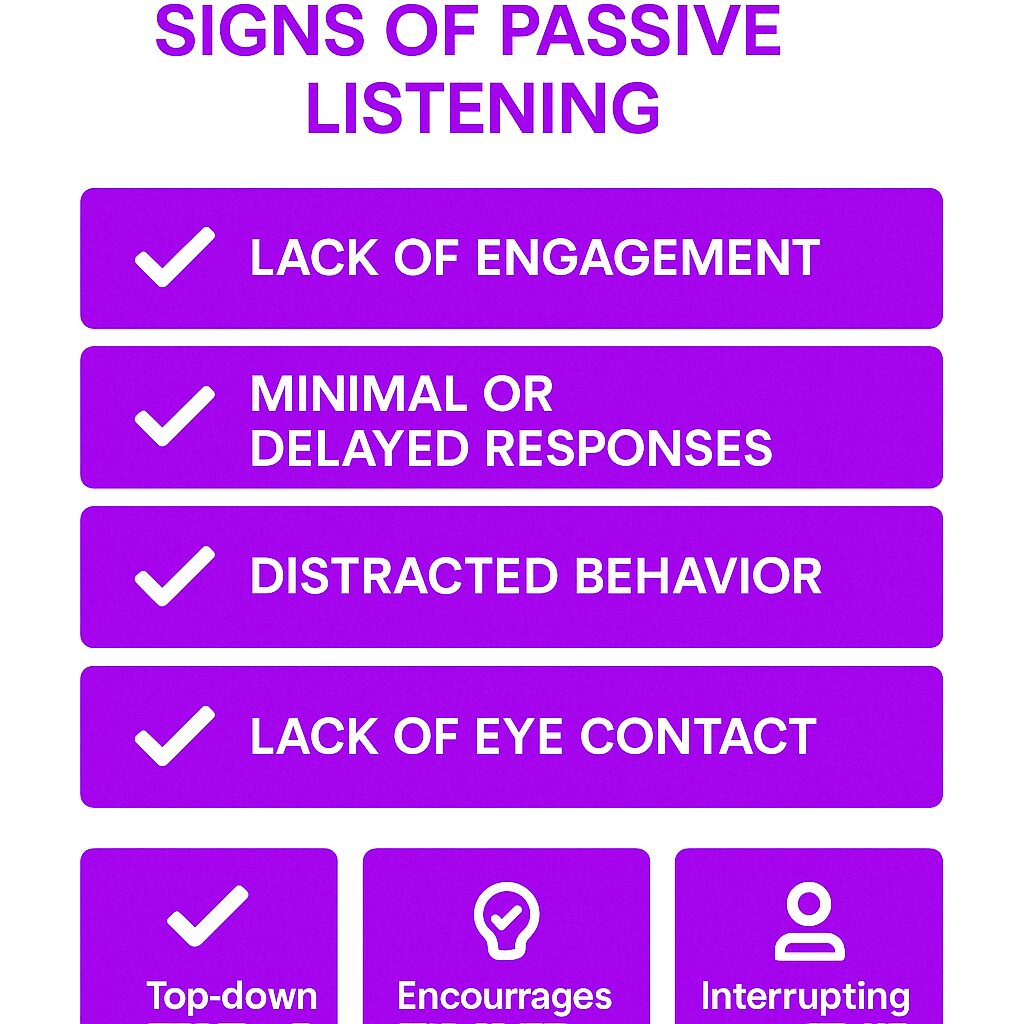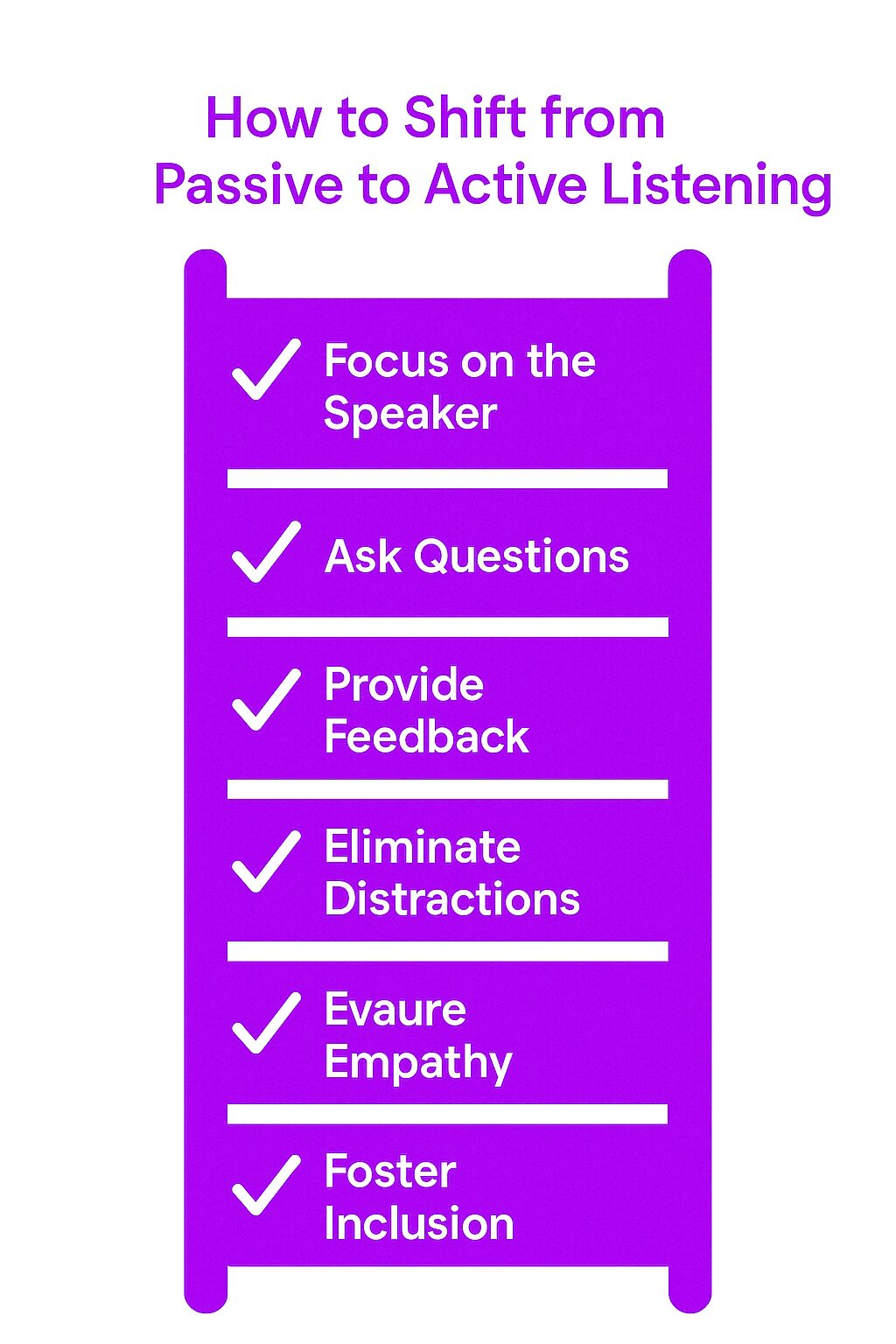What is Passive Listening?
Passive listening happens when someone hears what is being said but does not fully engage with or process the information. The listener may appear attentive but is not actively engaged, meaning they are not maintaining eye contact or fully focusing on the speaker. This type of listening contrasts with active listening, which involves interaction, feedback, and deeper comprehension.
Everyday situations often involve passive listening. You might have the radio playing in the background while working or hear a coworker discussing a project without contributing to the conversation. While passive listening can be useful in some scenarios, it can also lead to miscommunication or a lack of understanding.
How Passive Listening Works
When someone engages in passive listening, they absorb information without actively processing it. The brain registers the sounds and words, but it does not engage in deep interpretation or critical thinking. Because there is no active engagement, the listener may not retain much of the information. Passive listeners often lack positive body language cues such as nodding or maintaining eye contact.
This is common in situations where the listener does not feel personally invested in the conversation or when background noise is present. For example, employees in a meeting might listen to a presentation without asking questions or responding. They may hear the content, but their minds are elsewhere.
Passive vs. Active Listening
Passive Listening
-
Hearing words without fully processing them
-
Little or no response to the speaker
-
Low engagement and minimal comprehension
-
Common in background noise situations
Active Listening
-
Being an active listener involves paying full attention to the speaker
-
Asking questions or providing feedback
-
Engaging in the discussion and processing information
-
Retaining key points and understanding the message
Active listening requires effort and concentration, whereas passive listening is more passive in nature. The choice between the two depends on the situation and the listener’s level of interest.
Characteristics of a Passive Listener
-
Limited Interaction: A passive listener does not ask questions or offer feedback.
-
Minimal Retention: Information is easily forgotten because there is no active engagement.
-
Non-Verbal Cues: A passive listener might nod or maintain eye contact but may not actually be processing what is being said.
-
Disinterest or Distraction: The listener might be thinking about something else while appearing to pay attention.
-
No Clarification: If something is unclear, a passive listener does not seek clarification.
Understanding one’s listening style can help improve engagement and communication by identifying areas for active listening and better interaction.
Signs of Passive Listening
Passive listening can manifest in various ways, and recognizing the signs is crucial to improving communication skills. Some common signs of passive listeners include:
-
Lack of Engagement: Passive listeners may appear disinterested or disconnected from the conversation. They might not show any enthusiasm or curiosity about the topic being discussed.
-
Minimal or Delayed Responses: Passive listeners often give short, generic answers or respond slowly, indicating a lack of attention or processing. This can make the conversation feel one-sided and unproductive.
-
Distracted Behavior: Passive listeners may fidget, play with their phone, or engage in other activities while listening. This behavior signals that they are not fully engaged in the conversation.
-
Lack of Eye Contact: Passive listeners may avoid maintaining eye contact or focus on something else entirely. This can make the speaker feel ignored or undervalued.
-
Interrupting or Talking Over Others: Passive listeners may interrupt or talk over others, indicating a lack of respect for the speaker’s message. This can lead to frustration and hinder effective communication.
When Passive Listening is Useful
Not every situation requires full engagement. Passive listening can be useful in certain circumstances:
-
Background Listening: When working or doing another task, people often listen to music, podcasts, or the news without full focus.
-
Exposure to New Languages: Listening passively to the target language can help with familiarization, even if comprehension is low. Engaging with the target language through various listening activities can significantly aid in language acquisition and immersion.
-
Low-Priority Information: Some meetings or presentations may contain information that does not directly impact the listener.
-
Relaxation: Music or ambient sounds can provide a calming effect without requiring active focus.
When Passive Listening Becomes a Problem
While passive listening has its place, it can also create issues:
-
Lack of Understanding: Important details can be missed if a listener is not fully engaged.
-
Miscommunication: Without clarifying or responding, misunderstandings can arise. Paying attention can help avoid these misunderstandings and improve communication.
-
Reduced Productivity: If employees passively listen during meetings, they may not act on the information provided.
-
Weakened Relationships: In personal and professional settings, failing to listen actively can make others feel unheard or unappreciated.
The Impact of Passive Listening
Passive listening can have significant consequences on personal and professional relationships. Some of the impacts of passive listening include:
-
Misunderstandings and Miscommunications: Passive listening can lead to misunderstandings and miscommunications, which can damage relationships and hinder progress. When important details are missed, it can result in errors and confusion.
-
Missed Opportunities: Passive listeners may miss important information, opportunities, or cues, leading to missed chances and regret. This can affect career growth and personal development.
-
Poor Decision-Making: Passive listening can lead to poor decision-making, as individuals may not fully consider the information or perspectives presented. This can result in suboptimal outcomes and mistakes.
-
Damaged Relationships: Passive listening can damage relationships, as individuals may feel unheard, unvalued, or disrespected. This can erode trust and weaken connections over time.
-
Lack of Trust and Empathy: Passive listening can erode trust and empathy in relationships, leading to a breakdown in communication and collaboration. When people feel that their concerns are not being heard, it can create a barrier to effective teamwork.
How to Shift from Passive to Active Listening
Active listening improves comprehension and relationships. Here are ways to move from passive to active listening:
Focus on the Speaker
-
Make eye contact and stay actively engaged to avoid distractions.
-
Show engagement through nodding and facial expressions.
-
Set aside unrelated thoughts to fully concentrate on the conversation.
Ask Questions
-
Clarify details if something is unclear.
-
Summarize what the speaker has said to confirm understanding.
-
Engage with follow-up questions that show interest in the topic.
Provide Feedback by Actively Listening
-
Respond with relevant comments or examples.
-
Paraphrase key points to show comprehension.
-
Avoid interrupting, but acknowledge the speaker’s message.
Eliminate Distractions
-
Put away electronic devices.
-
Avoid multitasking while listening.
-
Choose a quiet environment when possible.
Practicing Empathy
Practicing empathy is an essential aspect of active listening. Empathy involves understanding and sharing the feelings of others, which can help build trust, rapport, and deeper understanding. To practice empathy, try the following:
-
Put Yourself in Others’ Shoes: Try to see things from the speaker’s perspective and understand their emotions and concerns. This helps in building a connection and showing that you care.
-
Use Active Listening Skills: Maintain eye contact, nod, and ask open-ended questions to show that you are engaged and interested. These actions demonstrate that you are fully engaged in the conversation.
-
Reflect Emotions: Reflect the speaker’s emotions back to them, using phrases like “I can see that you’re feeling frustrated” or “I sense that you’re excited.” This shows that you are attuned to their emotional state.
-
Show Understanding: Show that you understand the speaker’s perspective by summarizing or paraphrasing their message. This confirms that you are actively listening and processing the information.
-
Be Patient and Non-Judgmental: Be patient and non-judgmental, allowing the speaker to share their thoughts and feelings without interruption or criticism. This creates a safe space for open communication.
Passive Listening in the Workplace
Work environments often require a mix of active and passive listening. Understanding when to use each type can improve communication and productivity.
When Passive Listening is Used
-
Employees listen to company-wide announcements that do not directly affect them.
-
Team members attend meetings but do not actively participate.
-
Workers play background music or podcasts while focusing on tasks.
When Active Listening is Needed
-
During one-on-one conversations with managers or colleagues.
-
In brainstorming sessions where ideas and input are expected.
-
When handling customer complaints or addressing concerns.
Companies benefit when employees practice active listening in discussions that require engagement. Passive listening is fine for absorbing general information but should not be relied upon for critical communications.
Passive Listening in Education
Classrooms and training programs often involve passive and active listening. Students may hear a lecture without fully engaging, leading to limited retention of information. To improve learning outcomes, educators encourage active listening through interactive discussions, note-taking, and participation.
Strategies to Reduce Passive Listening in Learning
-
Encouraging students to summarize key points after a lesson.
-
Using discussion-based teaching methods instead of lectures alone.
-
Assigning interactive tasks that require students to apply what they hear.
Effective Listening in One on One Conversations
Related Concepts in Listening Skills
-
Selective Listening: Filtering out information and only focusing on what seems important.
-
Mindful Listening: Fully focusing on the speaker without distractions or judgment.
-
Empathetic Listening: Understanding the emotions behind the words being spoken.
Real-World Examples of Passive Listening
Corporate Meetings
Employees often sit through meetings where only a portion of the information is relevant to them. Some engage in passively listening, catching key details when needed but tuning out the rest.
Online Learning
Students watching recorded lectures may engage in passive listening rather than taking notes or actively engaging with the material.
Customer Service Calls
Customers sometimes passively listen to service representatives without fully processing instructions or solutions, leading to repeated issues.
Podcast Consumption
Many people play podcasts while driving or exercising. They hear the content but may not fully engage or remember details later.
Final Thoughts
Passive listening happens in many aspects of daily life. While it has its place, it is important to recognize when active listening is required for better understanding, stronger relationships, and improved productivity. Training employees, students, and individuals to engage more effectively in conversations can lead to better communication and deeper comprehension. Active listeners, by asking follow-up questions and providing feedback, can foster better understanding and stronger relationships.







